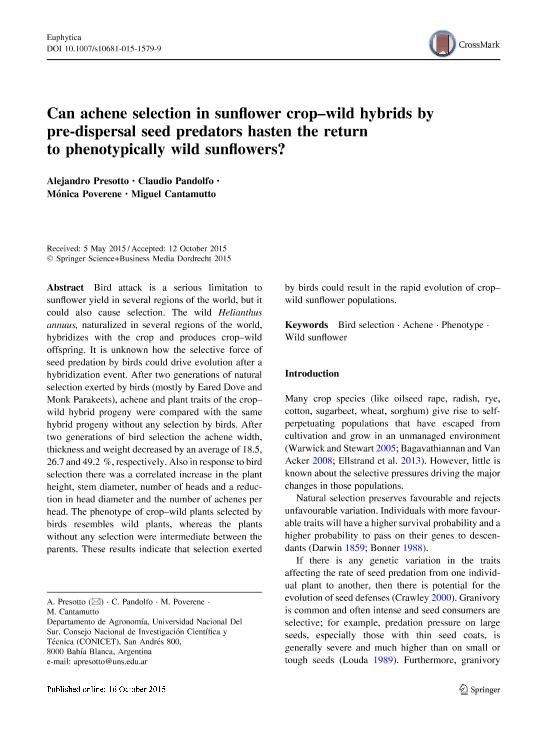Artículo
Can achene selection in sunflower crop–wild hybrids by pre-dispersal seed predators hasten the return to phenotypically wild sunflowers?
Presotto, Alejandro Daniel ; Pandolfo, Claudio Ezequiel
; Pandolfo, Claudio Ezequiel ; Poverene, María Mónica
; Poverene, María Mónica ; Cantamutto, Miguel Ángel
; Cantamutto, Miguel Ángel
 ; Pandolfo, Claudio Ezequiel
; Pandolfo, Claudio Ezequiel ; Poverene, María Mónica
; Poverene, María Mónica ; Cantamutto, Miguel Ángel
; Cantamutto, Miguel Ángel
Fecha de publicación:
16/04/2015
Editorial:
Springer
Revista:
Euphytica
ISSN:
0014-2336
e-ISSN:
1573-5060
Idioma:
Inglés
Tipo de recurso:
Artículo publicado
Clasificación temática:
Resumen
Bird attack is a serious limitation to sunflower yield in several regions of the world, but it could also cause selection. The wild Helianthus annuus, naturalized in several regions of the world, hybridizes with the crop and produces crop–wild offspring. It is unknown how the selective force of seed predation by birds could drive evolution after a hybridization event. After two generations of natural selection exerted by birds (mostly by Eared Dove and Monk Parakeets), achene and plant traits of the crop–wild hybrid progeny were compared with the same hybrid progeny without any selection by birds. After two generations of bird selection the achene width, thickness and weight decreased by an average of 18.5, 26.7 and 49.2 %, respectively. Also in response to bird selection there was a correlated increase in the plant height, stem diameter, number of heads and a reduction in head diameter and the number of achenes per head. The phenotype of crop–wild plants selected by birds resembles wild plants, whereas the plants without any selection were intermediate between the parents. These results indicate that selection exerted by birds could result in the rapid evolution of crop–wild sunflower populations.
Palabras clave:
Bird Selection
,
Achene
,
Phenotype
,
Wild Sunflower
Archivos asociados
Licencia
Identificadores
Colecciones
Articulos(CCT - BAHIA BLANCA)
Articulos de CTRO.CIENTIFICO TECNOL.CONICET - BAHIA BLANCA
Articulos de CTRO.CIENTIFICO TECNOL.CONICET - BAHIA BLANCA
Citación
Presotto, Alejandro Daniel; Pandolfo, Claudio Ezequiel; Poverene, María Mónica; Cantamutto, Miguel Ángel; Can achene selection in sunflower crop–wild hybrids by pre-dispersal seed predators hasten the return to phenotypically wild sunflowers?; Springer; Euphytica; 208; 3; 16-4-2015; 453-462
Compartir
Altmétricas



